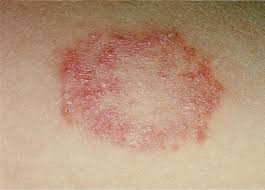
Tinea is a highly contagious fungal skin infection that affects the feet (athlete’s foot/tinea pedis), groin (jock itch/tinea cruris), scalp and skin underneath the breasts, fingernails and toenails.
The fungus thrives in warm, moist environments and it can be spread by skin-to-skin contact or indirectly via clothing, towels, linens and floors.
Symptoms
Infection is not usually serious but can be uncomfortable and have the following symptoms:
- Itching and stinging in the affected area.
- A red scaly patch that sometimes looks like a ring – this is often called ringworm (tinea corporis), however there is no worm involved.
- Blistering, cracking, splitting and peeling skin, particularly between the toes.
- Nails may develop a yellow or white discolouration (onychomycosis).
- Bald spots can appear on the scalp (tinea capitis).
Treatment
Treatment with antifungal medicines and good hygiene will help clear the infection.
- Anti-fungal creams and ointments can be purchased across the counter in a pharmacy, however speak to your pharmacist first.
- Use creams as directed – it can take weeks or months for the infection to clear and remember to continue the treatment even after the tinea appears to have gone.
- Some infections may not clear or keep coming back – this may require antifungal medication in tablet form from a doctor.
- Wash your hands after applying treatments.
- Keep the infected area dry and clean.
- Change your clothing such as socks, stockings and bra each day.
Prevention
Good hygiene can prevent tinea from recurring, such as drying skin thoroughly, particularly between toes, the groin and under breasts. You should never share bathmats, towels, shoes etc. when you have tinea because it is highly contagious. It will also help to:
- Wear thongs in public areas to prevent infection from floor surfaces such as wet areas in public showers, gyms and pools.
- Expose skin to as much air as possible.
- Wear cotton socks and using antiperspirants to control excessive sweating.
Find out more about this topic on Better Health Channel.
Fast facts:
- Tinea is a highly contagious fungal skin infection that thrives in warm, moist environments.
- A red patch can appear, and the skin can become uncomfortable and itchy.
- Anti-fungal creams and tablets typically heal the infection.
References used for this topic
Better Health Channel
Tinea
Healthdirect
Tinea
World Health Organisation
Ringworm (tinea)
|
|